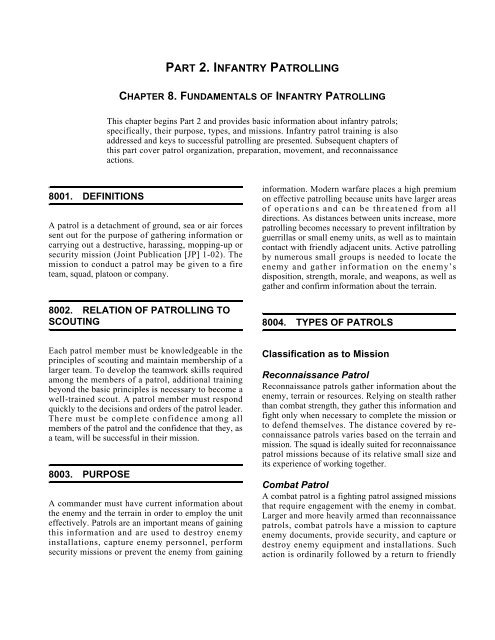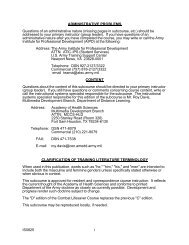MCWP-3-11.3-Scouting-and-Patrolling
MCWP-3-11.3-Scouting-and-Patrolling
MCWP-3-11.3-Scouting-and-Patrolling
Create successful ePaper yourself
Turn your PDF publications into a flip-book with our unique Google optimized e-Paper software.
PART 2. INFANTRY PATROLLINGCHAPTER 8. FUNDAMENTALS OF INFANTRY PATROLLINGThis chapter begins Part 2 <strong>and</strong> provides basic information about infantry patrols;specifically, their purpose, types, <strong>and</strong> missions. Infantry patrol training is alsoaddressed <strong>and</strong> keys to successful patrolling are presented. Subsequent chapters ofthis part cover patrol organization, preparation, movement, <strong>and</strong> reconnaissanceactions.8001. DEFINITIONSA patrol is a detachment of ground, sea or air forcessent out for the purpose of gathering information orcarrying out a destructive, harassing, mopping-up orsecurity mission (Joint Publication [JP] 1-02). Themission to conduct a patrol may be given to a fireteam, squad, platoon or company.8002. RELATION OF PATROLLING TOSCOUTINGinformation. Modern warfare places a high premiumon effective patrolling because units have larger areasof operations <strong>and</strong> can be threatened from alldirections. As distances between units increase, morepatrolling becomes necessary to prevent infiltration byguerrillas or small enemy units, as well as to maintaincontact with friendly adjacent units. Active patrollingby numerous small groups is needed to locate theenemy <strong>and</strong> gather information on the enemy’sdisposition, strength, morale, <strong>and</strong> weapons, as well asgather <strong>and</strong> confirm information about the terrain.8004. TYPES OF PATROLSEach patrol member must be knowledgeable in theprinciples of scouting <strong>and</strong> maintain membership of alarger team. To develop the teamwork skills requiredamong the members of a patrol, additional trainingbeyond the basic principles is necessary to become awell-trained scout. A patrol member must respondquickly to the decisions <strong>and</strong> orders of the patrol leader.There must be complete confidence among allmembers of the patrol <strong>and</strong> the confidence that they, asa team, will be successful in their mission.8003. PURPOSEA comm<strong>and</strong>er must have current information aboutthe enemy <strong>and</strong> the terrain in order to employ the uniteffectively. Patrols are an important means of gainingthis information <strong>and</strong> are used to destroy enemyinstallations, capture enemy personnel, performsecurity missions or prevent the enemy from gainingClassification as to MissionReconnaissance PatrolReconnaissance patrols gather information about theenemy, terrain or resources. Relying on stealth ratherthan combat strength, they gather this information <strong>and</strong>fight only when necessary to complete the mission orto defend themselves. The distance covered by reconnaissancepatrols varies based on the terrain <strong>and</strong>mission. The squad is ideally suited for reconnaissancepatrol missions because of its relative small size <strong>and</strong>its experience of working together.Combat PatrolA combat patrol is a fighting patrol assigned missionsthat require engagement with the enemy in combat.Larger <strong>and</strong> more heavily armed than reconnaissancepatrols, combat patrols have a mission to captureenemy documents, provide security, <strong>and</strong> capture ordestroy enemy equipment <strong>and</strong> installations. Suchaction is ordinarily followed by a return to friendly



